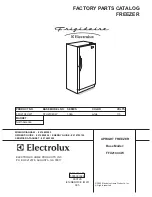
4.4 Insertion into a row of kitchen units
Fig. 8
(1) Stack cabinet
(3) Kitchen cabinet
(2) Appliance
(4) Wall
The appliance can be built into kitchen units. A top cupboard
Fig. 8 (2)
can be added above the appliance in order to bring
the appliance
Fig. 8 (1)
up to the height of the fitted kitchen
units.
When retrofitting with kitchen cabinets (max. depth 580 mm)
the appliance can be installed directly next to the cabinet
Fig. 8 (3)
. The appliance door projects 34 mm from the front of
the kitchen cabinet at the side and 50 mm at the centre of the
appliance. This is so that it can be opened and closed easily.
Ventilation requirements:
-
At the back of the stack cabinet there has to be a ventilation
duct of at least 50 mm depth throughout the width of the
stack cabinet.
-
The cross section of the ventilation gap below the ceiling
must be at least 300 cm
2
.
-
the larger the ventilation space, the more energy-saving the
appliance is in operation.
If the appliance is installed with the hinges next to a wall
Fig. 8 (4)
, the distance between appliance and wall has to be at
least 40 mm. This corresponds to the projection of the handle
when the door is open.
4.5 Disposing of packaging
WARNING
Danger of suffocation due to packing material and plastic film!
u
Do not allow children to play with packing material.
The packaging is made of recyclable materials:
-
corrugated board/cardboard
-
expanded polystyrene parts
-
polythene bags and sheets
-
polypropylene straps
-
nailed wooden frame with polyethylene panel*
u
Take the packaging material to an official collecting point.
4.6 Connecting the appliance
NOTICE
Failure to connect properly
Damage to the electronics.
u
Do not use a standalone inverter.
u
Do not use an energy saving plug.
WARNING
Failure to connect properly
Fire hazard.
u
Do not use an extension cable.
u
Do not use distributor blocks.
The type of current (alternating current) and voltage at the
installation site have to conform with the data on the type plate
(see Appliance at a glance).
The socket must be properly earthed and fused. The tripping
current for the fuse must be between 10 A and 16 A.
The socket must be easily accessible so that the appliance can
be quickly disconnected from the supply in an emergency. It
must be outside the area of the rear of the appliance.
u
Check the electrical connection.
u
Plug in the power plug.
4.7 Switching on the appliance
u
Press On/Off button
Fig. 3 (1)
.
w
The appliance is switched on. The temperature display and
the alarm button flash until the temperature is sufficiently
cold.
w
If all LEDs in the temperature display light up, demo mode is
activated. Please contact the after sales service.
5 Control
5.1 Door alarm
An audible warning sounds if the door is open for
longer than 60 seconds.
The audible warning stops automatically when the
door is closed.
5.1.1 Muting the door alarm
The audible alarm can be muted when the door is open. The
sound switch-off function is active as long as the door is left
open.
u
Press alarm button
Fig. 3 (5)
.
w
The door alarm is silenced.
5.2 Temperature alarm
The audible alarm sounds if the freezer temperature
is not cold enough.
The alarm button flashes at the same time.
The cause of the temperature being too high may be:
-
warm fresh food was placed inside
Control
* Depending on model and options
7






























